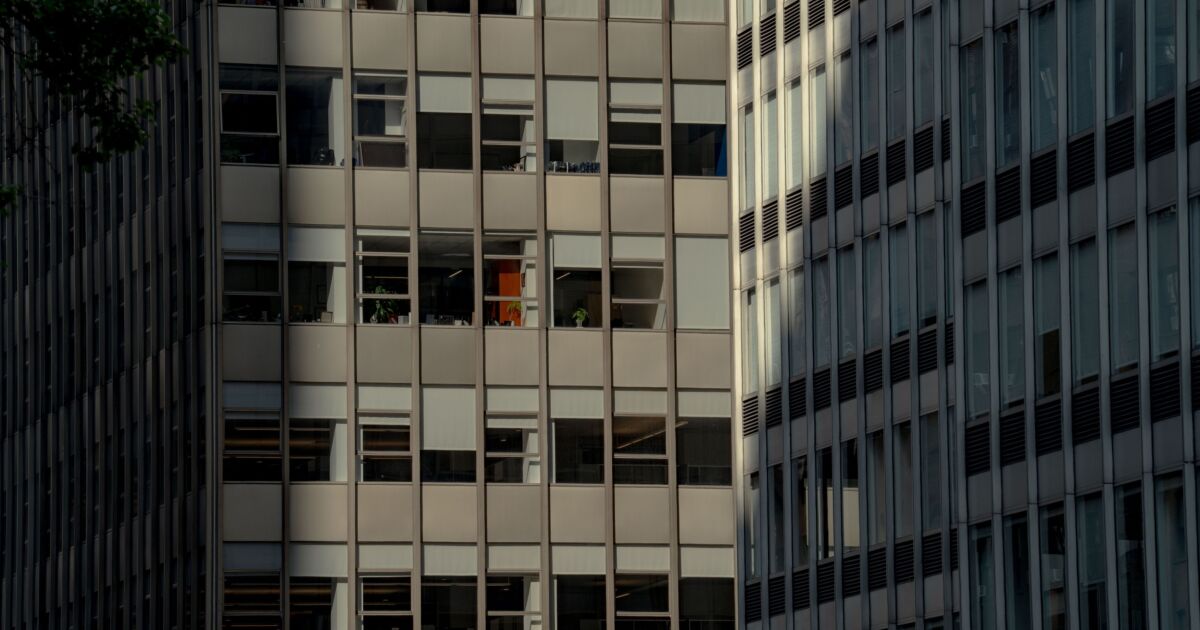The incredible shrinking office market tests New York City
7 min read
As New York City officials grapple with finding ways to balance their budget for the next fiscal year, one area of growing concern revolves around the very ground that the city is built on — commercial real estate.
Comptroller Brad Lander’s office last week took a .
While the effects of a lingering anemic office market may only be felt in future years, the weakness of that recently thriving sector hangs over the city’s budget negotiations.
There is only a week before the city hits its July 1 deadline for a balanced budget agreement.
Mayor Eric Adams and the City Council are negotiating on the $106.7 billion executive budget for fiscal 2024 that Adams proposed in April. The executive budget was up $4 billion from the preliminary plan the mayor released in January, but still has more cuts and cost savings than the council would like.
An enduring legacy of the pandemic has been a transformational shift to remote or hybrid work for many office jobs, the comptroller’s report said.
“While New York City’s economy has largely rebounded from the pandemic, the commercial real estate sector, in particular the office market, has not,” the report said. “The gradual trend toward remote work over the past few decades accelerated to warp speed in the spring of 2020, as almost all businesses that could operate remotely were required to do so.
“As the pandemic faded in 2022, some of the businesses that had gone fully remote continued that way, though most transitioned to hybrid work arrangements, with many workers telecommuting for two to three days out of the week,” the report said.
In the city, office attendance rates averaged around 50% on a typical workday while subway ridership was down about 35% from pre-pandemic levels during the workweek, according to the comptroller’s office.
Commercial real estate, and the office market in particular, is important to the city’s financial health. The city gets more than one-fifth of its property tax levy, and roughly 10% of its total taxes, from office buildings alone. Office Class A office buildings — the newest and most up-to-date facilities — make up 7% of the total property tax levy.
Initially during the pandemic, the city’s office market held up better than expected, the report noted, with many tenants staying on-time with rent. However, as office leases have come up for renewal, many companies have vacated or moved to smaller spaces. This has led to an upward trend in vacancy rates.
Now the New York City office market has “record high” vacancy rates, more severe than during the 2001 and 2008 recessions, the report said.
In a report released Thursday, S&P Global Markets said that nationally, large cities are facing a trifecta of pressures stemming from remote work — falling commercial property valuations, the potential for weaker tax collections in urban cores, and struggling public transit systems.
“We believe the most affected cities will see general obligation credit pressures amplify within the next few years, requiring management actions to preserve credit stability and enhance the economic vitality of many downtown spaces amid depressed activity,” S&P said.
The rating agency said although it believes “most large cities are equipped to meet near-term challenges if they are proactive in identifying potential revenue shortfalls and formulating timely solutions to sustain structural budgetary balance, significant outyear uncertainty remains, given that conditions in the commercial real estate market are still evolving.”
The city government is facing demands for hybrid work from its own employees.
Last month, Adams and District Council 37 executive director Henry Garrido announced the launch of a flexible work pilot program for city employees. The agreement will let some employees work remotely for up to two days per week.
“As we make this shift into a post-pandemic reality for offices, we must do it in a thoughtful way in partnership with our union leaders,” Adams said.
Under the agreement, the city and the unions also agreed to establish a work flexibility committee to discuss measures to enhance employee morale and recruitment and retention.
“The world of work has changed and this remote-hybrid pilot is one tool in our arsenal to provide a flexible workplace that still delivers the best services for New Yorkers,” Garrido said.
It takes some time before the effects of declining revenues can be felt, according to John Hallacy, founder of John Hallacy Consulting LLC.
“Assessed valuation declines do not lead to immediate changes in tax receipts. There is a process and the changes take time to work through the system,” Hallacy told The Bond Buyer on Friday.
“I would expect that there will need to be adjustments to budgets over the longer term. In the meantime, fund balances may buffer some of the downside until changes are made by legislatures across the land,” Hallacy said.
S&P also noted the growing trend of companies offering hybrid work schedules.
“The COVID-19 pandemic dramatically accelerated remote work trends, increasing work-from-home frequency by the equivalent of about four decades of pre-pandemic growth. The now broad-based acceptance of hybrid and remote work has meant that the once-anticipated broad-scale return-to-office appears to have largely stalled as of mid-2023,” S&P said.
The rating agency said that Kastle Systems “Back To Work Barometer” shows office occupancy in major U.S. office markets at just under 50%, where it has held relatively constant since the beginning of the year.
As office vacancies escalate, commercial real estate is bracing for a wild ride, S&P said.
“As loans used to finance office buildings mature and tenant leases expire in the next several years, we expect rebalancing in the current office market will play out until a new equilibrium is reached, with the interim period likely to see ongoing steadily falling office real estate valuations,” S&P said.
The rating agency said that office vacancy statistics for 15 major U.S. cities, including New York, indicate most have a vacancy rate higher than the U.S. average.
“As office leases that were in effect at the start of the pandemic expire, we expect vacancy rates will keep climbing as businesses reexamine their space needs and, in many cases, downsize or move to higher-quality class A office space, to the detriment of older class B and C buildings.”
Near-term macroeconomic softening will also drive up vacancy rates, as employers trim payrolls leading to rising unemployment rates through the next few years.
Cushman & Wakefield expects national vacancy rates will increase through 2023 and peak in 2024, before beginning a comeback that will depend on location-specific factors such as the pace of local jobs recovery, S&P said.
“Despite the challenges facing commercial real estate due to RTO trends, we do not expect a broad-based decline in general obligation credit quality among large U.S. cities, particularly those with a foundation of strong credit characteristics and the capacity to proactively manage emerging risks,” S&P said.
In a December policy brief, the Citizens Budget Commission noted the economic changes brought on by the COVID-19 pandemic had left the city’s office market facing an uncertain future.
“Daily occupancy rates remain well below pre-pandemic levels due to the persistence of remote work,” the CBC report said. “Many office buildings require significant investments to attract tenants and to comply with new building emissions requirements — cost pressures that come amidst flagging rents.”
When the office market last faced significant pressures in the 1990s, policymakers implemented a plan that focused on lower Manhattan, the center of the vacancy crisis, the CBC said. One of the plan’s components, the 421-g property tax incentive program, encouraged owners to convert obsolete office buildings to residential uses.
“While its efficiency has never been studied, 421-g helped achieve the city and state’s goals of sparking residential growth in lower Manhattan, stabilizing the office market, and proving the viability of office-to-residential conversions,” the CBC said.
The 421-g program can offer lessons for creating a cost-effective program to support office-to-residential conversions in today’s market, the CBC said.
Employment levels in the office-using sectors held steady through the pandemic, even as office vacancy rates rose, the CBC said, and barring any changes the market will likely enter the next recession with an abnormally high vacancy rate.
The uncertainty about the future of the office market presents an opportunity to convert underutilized or obsolete office buildings into much-needed housing, the CBC said.
“To make the most of the opportunity, however, careful study and thoughtful policy design are critically important. Policymakers have the chance to remove barriers to otherwise feasible conversion projects,” the CBC concluded. “If done well, conversions can enhance the long-term competitiveness of New York, protect its property tax base, and improve the lives of its residents, but this future is only possible if policymakers get the details right.”
New York City is one of the biggest issuers of municipal bonds. Its general obligation bonds are rated Aa2 by Moody’s Investors Service, AA by S&P Global Ratings and Fitch Ratings and AA-plus by Kroll Bond Rating Agency.
In the second quarter of fiscal 2023, it had about $39.3 billion of GO bonds outstanding. Separately, the city’s Transitional Finance Authority and Municipal Water Finance Authority have $45.1 billion and $32.3 billion outstanding respectively.







